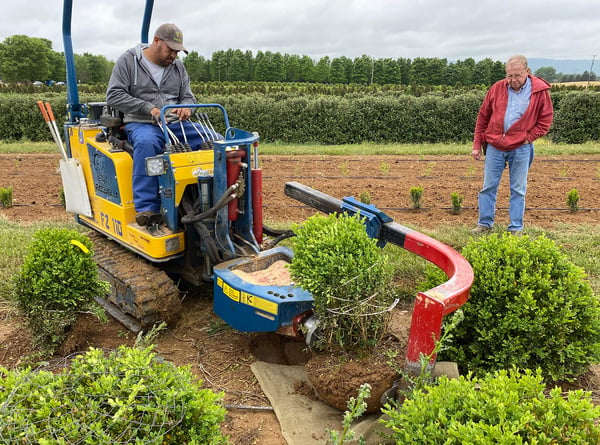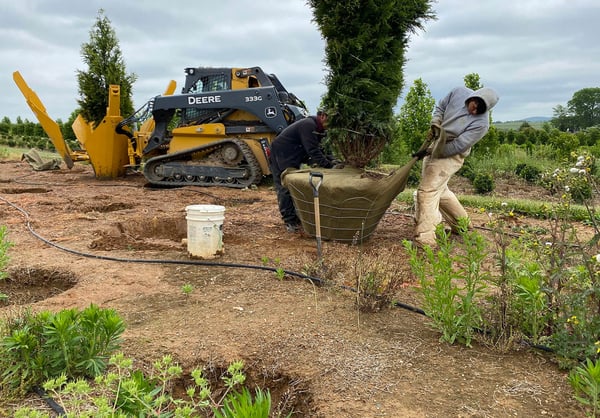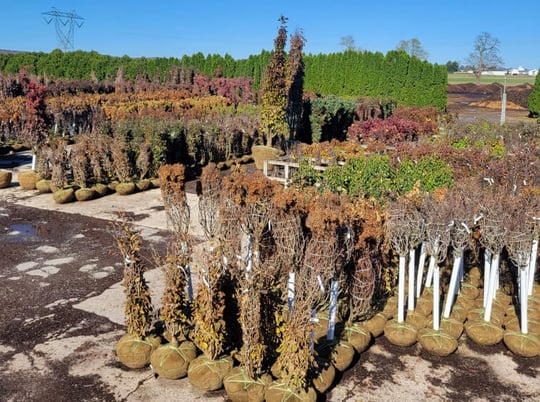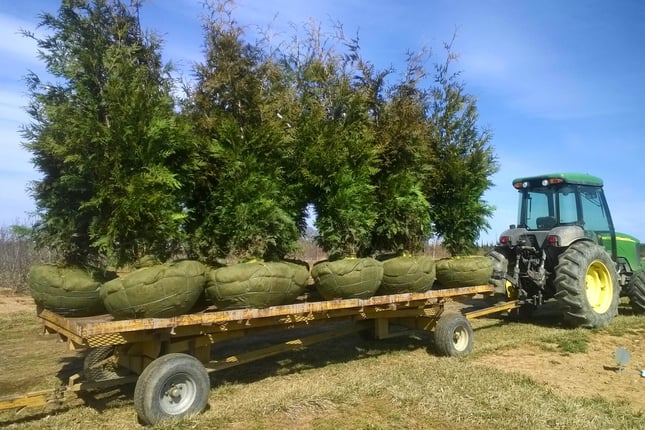This is a business where patience is a hard-won virtue. Some days I’m more virtuous than others. But I do know that when it comes to delivering plants that are truly ready for market, timing -and therefore patience- is everything.
We get the question all the time: “How soon can we get our order?” It all depends on the time of the year, and the best time to dig for the plants on the order list. It’s a balancing act for all of us. But as a field production grower for nurseries and landscapers all over the mid-Atlantic and Northeast, we’ve learned that the right time to dig is when the plant is ready.
So how do we figure that out? Decades of experience helps--which included some trial and error especially in the early days. But that’s how you learn, and that’s what I want to share with you now.
When getting ready to deliver plants for our clients, we have to time digging based on the season and developmental stage of the plant to maximize its survival. In some cases, it’s a pretty simple decision. High volume harvest occurs for all plants from February through the end of April. Ilex, Buxus and conifers can be dug year round, so we can get those to customers as needed.
But what about when things get more complex? How do we decide when and what to dig for summer and fall? Well, it’s the plants that do the deciding, so here’s what we look for and how we make the timing work for you and the plants.
Summer Digging Best Practices
 There are some circumstances where ‘just-in-time’ summer digging can be done, delivered on the exact day needed, often right to the job site. It saves back-and forth for landscape contractors, and wholesale distribution yards can source material as needed for their customers.
There are some circumstances where ‘just-in-time’ summer digging can be done, delivered on the exact day needed, often right to the job site. It saves back-and forth for landscape contractors, and wholesale distribution yards can source material as needed for their customers.
That’s all well and good, yet summer digging can get a little tricky. I know some nurseries won’t dig in the summer because of the risk of failure or previous bad outcomes. Sandy soils, for instance, can yield poor results.
There really is an art to summer digging. To have the most success with it, plants must be very well hydrated whether you’re using irrigation or individual treatment. Here are the steps we take to get plants from our farm to clients in the heat of the summer.
Step One
We inject high volumes of water into the root zone of each plant prior to digging.
Step Two
In the second phase, we make a thorough application of 2% Vapor Guard to the plant. Vapor Guard is a water emulsifiable organic concentrate used to reduce water transpiration. The soft, flexible film formed after the spray application dries will reduce moisture loss from plant foliage without interfering with normal transpiration.
Step Three
After a 24–48 hour wait, we dig a somewhat larger ball than typical of dormant harvest. The ball may be as much as 15% larger depending on the specific plant. We then move the material from the field to a structure to eliminate the stresses of sun and wind, and aggressively irrigate it until picked up or loaded for delivery.
Fall Digging and Managing Fall Hazard Plants
 Fall digging is as tricky as summer digging, but for different reasons, especially for fall hazard plants. Carpinus, Fagus, Betula, and Cercis are examples of fall hazard plants. I’ve done a lot of research, and still haven't found the final word on when the fall hazard period begins and ends.
Fall digging is as tricky as summer digging, but for different reasons, especially for fall hazard plants. Carpinus, Fagus, Betula, and Cercis are examples of fall hazard plants. I’ve done a lot of research, and still haven't found the final word on when the fall hazard period begins and ends.
If at all possible these plants should not be dug from September through mid-February. There are always projects that are “must do.” So there are going to be exceptions to the rule. When a “must do” project comes along for fall hazard plants, we suggest that once they are replanted, they be heavily mulched until spring, regularly watered, and provided with wind protection. The same applies to evergreens dug in the fall.
Summer or Fall - Timing is Everything
 As much as some may wish it to be, a plant order is not a same day affair. Here is the reality we work under: fulfilling an order is a process that includes receiving the order, tagging it in the field, delivering a dig sheet to the field staff, digging, and prepping for safe transport. The field staff are usually booked up to two weeks in advance during the spring and up to a week in the summer and fall. Same day plant delivery just is not a promise that is easily delivered on.
As much as some may wish it to be, a plant order is not a same day affair. Here is the reality we work under: fulfilling an order is a process that includes receiving the order, tagging it in the field, delivering a dig sheet to the field staff, digging, and prepping for safe transport. The field staff are usually booked up to two weeks in advance during the spring and up to a week in the summer and fall. Same day plant delivery just is not a promise that is easily delivered on.
You know this and I know this, but it bears repeating: The ideal way to receive plants in a timely manner is to plan ahead. The earlier your grower receives an order against your tight schedule the more likely they are to be able to meet a deadline. The more you understand the how, the what, and the when of digging, the better you’ll be able to prepare for upcoming projects and inventory, delivering what your clients and customers want when they want it.
Reserving the plants you need for when you need them can be a real challenge. Download our ebook Solving Plant Shortages in a High Demand Landscaping Market to learn about practical solutions to common plant sourcing problems.





